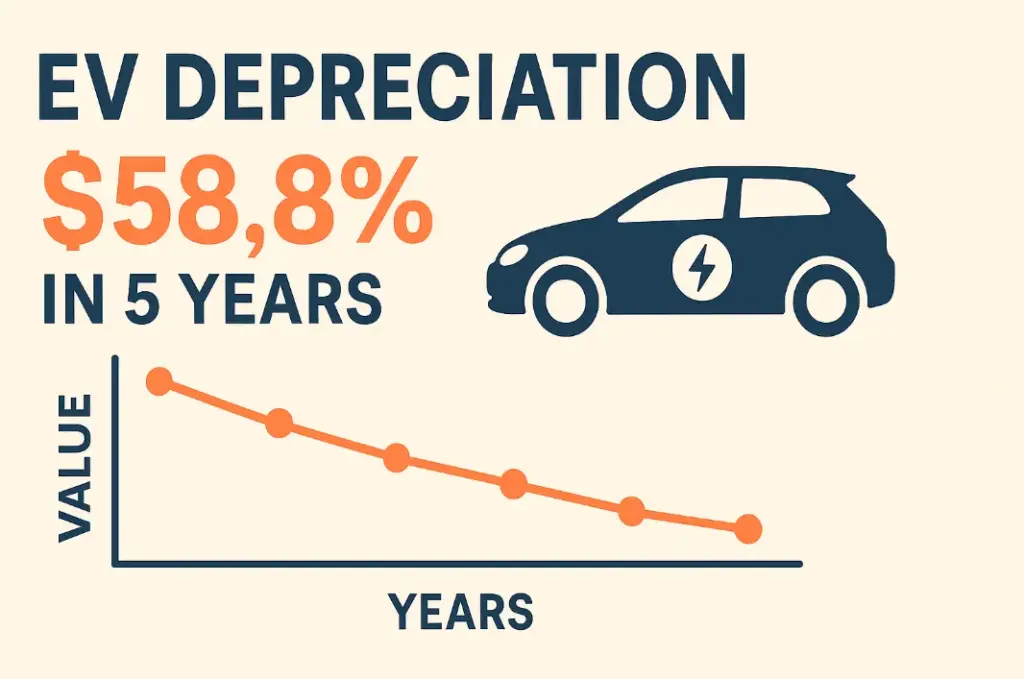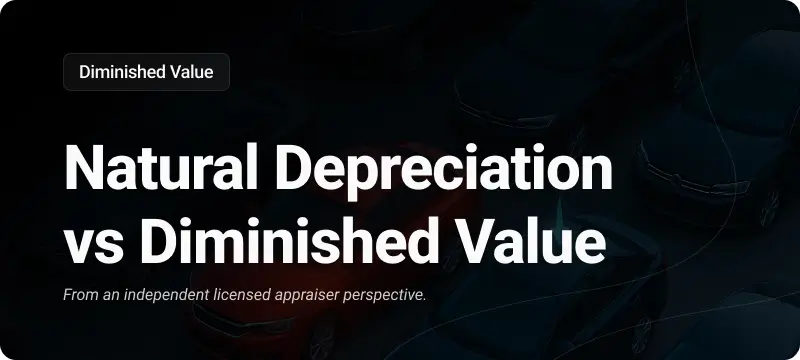Electric vehicles (EVs) are gaining ground in the automotive market, but many buyers are shocked by how quickly these cars lose value. According to recent studies, EVs lose up to 58.8% of their value within five years—a much higher drop than traditional gas-powered cars.
In this article, you’ll learn:
- How EV depreciation compares to gas and diesel vehicles
- Which EVs hold or lose value the fastest
- The 5 main reasons EVs depreciate quicker
- What this trend means for buyers and car dealerships
- If resale values are improving in today’s market
By the end, you’ll understand the full picture behind EV resale trends—and whether it’s the right time to buy, sell, or stock used electric cars.
Bonus Resource: Check out the top 10 fastest depreciating cars in the U.S. for even more data on vehicle value loss.
What Is EV Depreciation?

Vehicle depreciation is the amount of value a car loses over time. All cars depreciate, but electric vehicles now lose more value than any other segment in the auto industry.
A new iSeeCars study (March 2025) found that EVs lose an average of 58.8% of their value within five years. That’s far higher than:
- Gas and diesel cars (around 45.6%)
- Hybrids (40.7%)
- Trucks (40.4%)
How It Compares to Traditional Vehicles
- EVs depreciate fast in part due to battery life concerns and rapid tech changes.
- ICE vehicles (gas/diesel) follow a more gradual curve and hold value longer.
- Hybrids have become a standout in value retention thanks to reliability and fuel efficiency.
Depreciation isn’t always negative—it creates opportunities in the used market. But for new EV buyers, this drop means thousands in lost value, making it an essential factor to consider before buying.
The Data Behind the 58.8% Drop
The 58.8% depreciation figure isn’t a rough estimate—it’s backed by hard data from iSeeCars’ March 2025 study. After analyzing over 800,000 five-year-old used vehicles, the study found that electric vehicles experience the steepest value drop across all vehicle segments.
This trend is even more noticeable when comparing specific models.
EVs With the Worst Resale Value
Some electric models stand out for just how much value they lose in five years:
| Rank | Model | 5-Year Depreciation | Avg. Dollar Loss |
|---|---|---|---|
| 1 | Jaguar I-PACE | 72.2% | $51,953 |
| 2 | Tesla Model S | 65.2% | $52,165 |
| 3 | Nissan LEAF | 64.1% | $18,043 |
| 4 | Tesla Model X | 63.4% | $53,846 |
| 5 | Porsche Taycan | 60.1% | $59,691 |
| 6 | Tesla Model Y | 60.4% | $36,225 |
| 7 | Kia Niro EV | 59.2% | $23,439 |
| 8 | Hyundai Kona Electric | 58.0% | $19,062 |
| 9 | Tesla Model 3 | 55.9% | $23,771 |
These vehicles lose between $36,000 and $52,000 on average over five years, making them risky new purchases if resale value matters to you.
EVs That Hold Their Value Better
Only a few electric cars perform better than the segment average:
- Tesla Model 3 – 55.9% depreciation
- Hyundai Kona Electric – 58.0%
While still higher than the overall industry average (45.6%), these models represent the top performers among EVs for holding value.
5 Key Reasons EVs Depreciate Faster
EVs offer clean tech and lower fuel costs, but that doesn’t guarantee long-term value. Here are the top reasons electric vehicles lose resale value faster than gas or hybrid models.
1. Battery Health & Range Anxiety
An EV’s battery is its most expensive and essential component. Over time, batteries degrade—reducing range and buyer confidence.
- Frequent fast charging and extreme temperatures can speed up wear.
- Used EV buyers often worry about costly battery replacement or reduced performance.
2. Rapid Tech Obsolescence
EV technology is evolving fast.
- Newer models come with better range, faster charging, and advanced software.
- That makes 3–5 year-old EVs feel outdated, even if they’re still functional.
This fast pace of innovation leads to accelerated depreciation.
3. Brand Reputation
Some EV brands simply hold value better.
- Tesla and Hyundai models perform better in resale value because of strong consumer trust and software updates.
- Lesser-known brands or first-generation EVs lack that support, making them harder to sell.
4. Charging Infrastructure
In areas with limited charging stations, demand for used EVs is lower.
- Buyers want the convenience of public charging access—especially if they can’t charge at home.
- Poor infrastructure makes EV ownership feel risky, reducing buyer interest.
5. Market Forces & Incentives
Several external factors also push prices down:
- Price cuts on new EVs (like Tesla’s repeated reductions) undercut used values.
- Government tax credits can skew perceived value.
Is EV Depreciation Slowing Down?
Yes—but it’s happening gradually and unevenly across the electric vehicle market.
While EVs still show the highest depreciation of any vehicle segment, some models are beginning to retain more of their value. This shift is largely driven by better battery technology, growing public familiarity with EVs, and wider access to charging infrastructure in many parts of the U.S.
Mainstream models like the Tesla Model 3 and Hyundai Kona Electric are showing stronger resale value than earlier electric vehicles or high-end luxury models. These newer EVs are more reliable, affordable, and practical for a wider range of drivers—making them more appealing in the used market.
However, the overall market remains sensitive. New EV prices continue to drop due to intense competition, price cuts by leading brands, and government tax incentives. This makes newer models more attractive and further devalues older used EVs. Additionally, a rising supply of off-lease electric vehicles is increasing competition among used EV sellers, pushing prices lower.
So, while depreciation is still a real issue, especially for luxury and first-generation models, some EVs are beginning to close the gap with gas and hybrid vehicles. The trend is promising—but for now, value retention depends heavily on the model, battery condition, and regional market demand.


